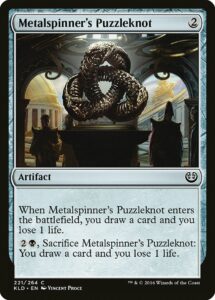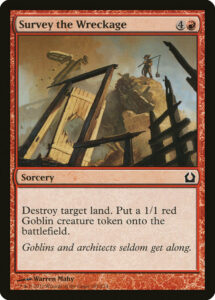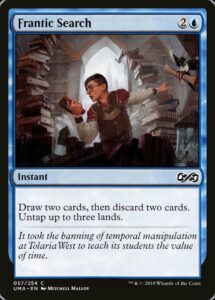For three years, I’ve toyed with the idea of constructing a cube that can recreate what I loved about Ultimate Masters. Back in late 2019, I pulled a thousand or so cards and aimed to actually build the cube in springtime. The pandemic stopped me in my tracks.
That pile of unsorted cards was an annoyance I kept intact during my pandemic moves, but I never got back to the project. Eventually, I deconstructed it during a major resorting of my collection and assumed the project was done. Then, CubeCon was announced and five hours suddenly disappeared from my life. Now, I have another giant pile cards—digital, this time—and am at the same crossroads I once was.
The Goal
Ultimate Masters is one of my favorite formats. I don’t count it as a greatest-of-all-time format, and I’ve loved the similar ones that followed (aka both Modern Horizons). Part of this affection is nostalgia—UMA was intended to be the last Masters format after the dismal performances of Iconic Masters and Masters 25. In 2018, it was the final entry of the Masters line, my favorite product line Wizards made—and it was an amazing last hurrah, reminding me of the glory days of every Masters from MMA2017 backwards.
What makes me love UMA is how it scratched a very specific itch, one I didn’t realize I had. I already knew that adore playing with value engines like Young Pyromancer, Treasure Cruise, and Spider Spawning. But neither Shadows over Innistrad nor Vintage Cube had prepared me for how awesome it feels to cast Frantic Search into Fiery Temper and Just the Wind, nor had I gotten to play with a Wild Mongrel in all its glory.
It reminded me of winning games in Innistrad draft with Laboratory Maniac back when I first getting decent at Magic, or losing to Furnace Celebration before I was decent. It recontextualized Conviction, Lotus-Eye Mystics, and Molten Birth, forgettable cards I’d played with previously, into dynamic, playable cards. It tied everything together, from Magic’s history to my own window within in, so incredibly well.

The Challenge
Getting back into cube design seemed easy. After all, I’ve been curating my own cube for nearly a decade, and cube drafting for even longer, so it should be facile to just make a second. That hubris stopped me cold in 2019, and it hit me hard this weekend when I was adding hundreds of cards to Cube Cobra.
The first three issues are obvious: I’m in the practice of maintaining a cube, swapping maybe 5-20 cards with each set release, but I haven’t constructed a cube from scratch since 2013. Secondly, I’m accustomed to dealing with physical cards that I can move around a table and tracking in a spreadsheet, while I have no experience designing a cube online. Third, I’ve never tried to replicate a set’s experience—I’ve build my cube design by feel and through iteration.
That last problem poses more questions: how do I replicate the feel of Ultimate Masters? Sure, I can break singleton to ensure that Frantic Search and Faithless Looting show up in sufficient quantities, but I don’t know how to build a set cube. And frankly, I want to create something inspired by UMA, not just a wholesale replication of that one set.
That leads to the question of just what constitutes UMA’s feel. Obviously there’s a major graveyard focus, but could I cut some of the archetypes and replace them with new ones? Can I maintain the set’s modularity, where Frantic Search was useful beyond blue-red Madness? I don’t want to create an environment like MMA2013—while I loved that set, it had hard lanes with minimal overlap.
Those are the thoughts that kept me from making any significant progress for the past three years. But the looming deadline of CubeCon got me excited enough to cut through the anxiety and dump 886 cards into a list.

The Situation
It might sound trite, but I’ve found the best way to work is to just start working. For me, that involves writing quickly and casually. I sifted through my old records of the original cube and wrote down the elements that most excited me. Eventually, I settled on four macro-archetypes that could hopefully hit my goal of feeling like UMA while being something new: Spells (Madness, Prowess, and Flashback), Tokens (Aristocrats, Swarm, increasing spell density), Graveyard (threshold strategies like Spider Spawning, graveyard-as-resource for Delve, and graveyard-for-advantage via Gravediggers, Disturb, and Flashback), and Artifacts (the other aggressive pillar, it can use the graveyard or ignore it).
Why Artifacts? I like them, I think they can synergize with the other strategies, and they’ve been a pillar of several Masters sets. I chose to exclude all powerful graveyard hate like Relic of Progenitus, opting for more targeted or slow pieces like Cremate and Scrabbling Claws. After writing all my ideas, I set to work, setting up Scryfall filters and adding cards as I thought of them. Eventually, I felt like I’d done enough work for a first draft, and stopped.
As of now, the cube has several apparent issues. For starters, I want it to be somewhere between 450 and 540 cards and it’s at 886. White has far fewer cards than any other color, though that might be a blessing since it still has too many cards, even for a 540. The goal is for there to be both balance between and synergy across archetypes; but I neither have that now, nor does it give me much help in which 400 or so cards I ought to cut.
The next step, cutting cards, is definitely less fun than adding cards, but it’s also an easier one. The possibility space of removing a few hundred cards is smaller than the possibility space of pulling from every Magic card ever. And I know from experience that a cut card can always come back in and therefore, should be recorded—so after the inevitable awkward first playtest, I can regroup, iterate, and play again.
While I don’t anticipate making the Cube Con deadline, I’ve enjoyed having it as an impetus to act. I’m neither sure if I’d want to submit anything, nor do I want to submit a completely untested list, but the exercise has been fun and rewarding regardless. It’s always good to be reminded of the lessons that sometimes one needs a little push to get working, that it’s fun to work on a project even if nothing comes of it, and that in cube design (as in many things), there are plenty of do-overs.
Zachary Barash is a New York City-based game designer and the last commissioner of Team Draft League. He designs for Kingdom Death: Monster, has a Game Design MFA from the NYU Game Center, and does freelance game design. When the stars align, he streams Magic (but the stars align way less often than he’d like).


